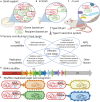Molecular Mechanisms Influencing Bacterial Conjugation in the Intestinal Microbiota
- PMID: 34149661
- PMCID: PMC8213034
- DOI: 10.3389/fmicb.2021.673260
Molecular Mechanisms Influencing Bacterial Conjugation in the Intestinal Microbiota
Abstract
Bacterial conjugation is a widespread and particularly efficient strategy to horizontally disseminate genes in microbial populations. With a rich and dense population of microorganisms, the intestinal microbiota is often considered a fertile environment for conjugative transfer and a major reservoir of antibiotic resistance genes. In this mini-review, we summarize recent findings suggesting that few conjugative plasmid families present in Enterobacteriaceae transfer at high rates in the gut microbiota. We discuss the importance of mating pair stabilization as well as additional factors influencing DNA transfer efficiency and conjugative host range in this environment. Finally, we examine the potential repurposing of bacterial conjugation for microbiome editing.
Keywords: antibiotic resistance; bacterial conjugation; conjugative plasmids (CP); mating pair stabilization; microbiota.
Copyright © 2021 Neil, Allard and Rodrigue.
Conflict of interest statement
The authors have filed a patent application for the use of conjugative plasmids for microbiome editing. KN and SR are co-founders of TATUM bioscience.
Figures

References
-
- Bahl M. I., Hansen L. H., Licht T. R., Sørensen S. J. (2007). Conjugative transfer facilitates stable maintenance of IncP-1 plasmid pKJK5 in Escherichia coli cells colonizing the gastrointestinal tract of the germ-free rat. Appl. Environ. Microbiol. 73 341–343. 10.1128/AEM.01971-06 - DOI - PMC - PubMed
Publication types
LinkOut - more resources
Full Text Sources
Miscellaneous

